Saunders Comprehensive NCLEX-RN Exam Review: UNIT 3; Foundations of Care. 300 Page Ch 8-16, and includes Questions, Answers and Rationale. 300 Pages
Document Content and Description Below
THIS DOCUMENT CONTAINS;
C H A P T E R 8: Fluids and Electrolytes
C H A P T E R 9: Acid-Base Balance
C H A P T E R 1 0: Vital Signs and Laboratory Reference
Intervals
C H A P T E R 11: Nutrition
...
C H A P T E R 1 2: Health and Physical Assessment of the
Adult Client
C H A P T E R 1 3: Provision of a Safe Environment
C H A P T E R 1 4: Calculation of Medication and
Intravenous Prescriptions
C H A P T E R 1 5: Perioperative Nursing Care
C H A P T E R 1 6: Positioning Clients
SAMPLE PRACTICE QUESTIONS
The nurse
notes that the client is dyspneic, and crackles are audible on auscultation.
What additional manifestations would the nurse expect to note in this client
if excess fluid volume is present?
1. Weight loss and dry skin
2. Flat neck and hand veins and decreased urinary output
3. An increase in blood pressure and increased respirations
4. Weakness and decreased central venous pressure (CVP)
40. The nurse reviews a client’s record and determines that the client is at risk for
developing a potassium deficit if which situation is documented?
1. Sustained tissue damage
2. Requires nasogastric suction
3. Has a history of Addison’s disease
4. Uric acid level of 9.4 mg/dL (557 mcmol/L)
41. The nurse reviews a client’s electrolyte laboratory report and notes that the
potassium level is 2.5 mEq/L (2.5 mmol/L). Which patterns should the nurse
watch for on the electrocardiogram (ECG) as a result of the laboratory value?
Select all that apply.
1. U waves
2. Absent P waves
3. Inverted T waves
4. Depressed ST segment
5. Widened QRS complex
42. Potassium chloride intravenously is prescribed for a client with heart failure
experiencing hypokalemia. Which actions should the nurse take to plan for
preparation and administration of the potassium? Select all that apply.
1. Obtain an intravenous (IV) infusion pump.
2632. Monitor urine output during administration.
3. Prepare the medication for bolus administration.
4. Monitor the IV site for signs of infiltration or phlebitis.
5. Ensure that the medication is diluted in the appropriate volume of
fluid.
6. Ensure that the bag is labeled so that it reads the volume of
potassium in the solution.
43. The nurse is assessing a client with a lactose intolerance disorder for a
suspected diagnosis of hypocalcemia. Which clinical manifestation would
the nurse expect to note in the client?
1. Twitching
2. Hypoactive bowel sounds
3. Negative Trousseau’s sign
4. Hypoactive deep tendon reflexes
44. The nurse is caring for a client with Crohn’s disease who has a calcium level
of 8 mg/dL (2 mmol/L). Which patterns would the nurse watch for on the
electrocardiogram? Select all that apply.
1. U waves
2. Widened T wave
3. Prominent U wave
4. Prolonged QT interval
5. Prolonged ST segment
45. The nurse reviews the electrolyte results of a client with chronic kidney
disease and notes that the potassium level is 5.7 mEq/L (5.7 mmol/L). Which
patterns would the nurse watch for on the cardiac monitor as a result of the
laboratory value? Select all that apply.
1. ST depression
2. Prominent U wave
3. Tall peaked T waves
4. Prolonged ST segment
5. Widened QRS complexes
46. Which client is at risk for the development of a sodium level at 130 mEq/L
(130 mmol/L)?
1. The client who is taking diuretics
2. The client with hyperaldosteronism
3. The client with Cushing’s syndrome
4. The client who is taking corticosteroids
47. The nurse is caring for a client with heart failure who is receiving high doses
of a diuretic. On assessment, the nurse notes that the client has flat neck
veins, generalized muscle weakness, and diminished deep tendon reflexes.
The nurse suspects hyponatremia. What additional signs would the nurse
expect to note in a client with hyponatremia?
1. Muscle twitches
2. Decreased urinary output
3. Hyperactive bowel sounds
4. Increased specific gravity of the urine
48. The nurse reviews a client’s laboratory report and notes that the client’s
serum phosphorus (phosphate) level is 1.8 mg/dL (0.58 mmol/L). Which
264condition most likely caused this serum phosphorus level?
1. Malnutrition
2. Renal insufficiency
3. Hypoparathyroidism
4. Tumor lysis syndrome
49. The nurse is reading a primary health care provider’s (PHCP’s) progress
notes in the client’s record and reads that the PHCP has documented
“insensible fluid loss of approximately 800 mL daily.” The nurse makes a
notation that insensible fluid loss occurs through which type of excretion?
1. Urinary output
2. Wound drainage
3. Integumentary output
4. The gastrointestinal tract
50. The nurse is assigned to care for a group of clients. On review of the clients’
medical records, the nurse determines that which client is most likely at risk
for a fluid volume deficit?
1. A client with an ileostomy
2. A client with heart failure
3. A client on long-term corticosteroid therapy
4. A client receiving frequent wound irrigations
51. The nurse caring for a client who has been receiving intravenous (IV)
diuretics suspects that the client is experiencing a fluid volume deficit. Which
assessment finding would the nurse note in a client with this condition?
1. Weight loss and poor skin turgor
2. Lung congestion and increased heart rate
3. Decreased hematocrit and increased urine output
4. Increased respirations and increased blood pressure
52. On review of the clients’ medical records, the nurse determines that which
client is at risk for fluid volume excess?
1. The client taking diuretics who has tenting of the skin
2. The client with an ileostomy from a recent abdominal surgery
3. The client who requires intermittent gastrointestinal suctioning
4. The client with kidney disease and a 12-year history of diabetes
mellitus
53. Which client is at risk for the development of a potassium level of 5.5 mEq/L
(5.5 mmol/L)?
1. The client with colitis
2. The client with Cushing’s syndrome
3. The client who has been overusing laxatives
4. The client who has sustained a traumatic burn
54. The nurse reviews the arterial blood gas results of a client and notes the
following: pH 7.45, Paco2 of 30 mm Hg (30 mm Hg), and HCO3– of 20 mEq/L
(20 mmol/L). The nurse analyzes these results as indicating which condition?
1. Metabolic acidosis, compensated
2. Respiratory alkalosis, compensated
3. Metabolic alkalosis, uncompensated
4. Respiratory acidosis, uncompensated
55. The nurse is caring for a client with a nasogastric tube that is attached to low
suction. The nurse monitors the client for manifestations of which disorder
that the client is at risk for?
1. Metabolic acidosis
2. Metabolic alkalosis
3. Respiratory acidosis
4. Respiratory alkalosis
56. A client with a 3-day history of nausea and vomiting presents to the
emergency department. The client is hypoventilating and has a respiratory
rate of 10 breaths per minute. The electrocardiogram (ECG) monitor displays
tachycardia, with a heart rate of 120 beats per minute. Arterial blood gases
are drawn and the nurse reviews the results, expecting to note which
finding?
1. A decreased pH and an increased Paco2
2. An increased pH and a decreased Paco2
3. A decreased pH and a decreased HCO3–
4. An increased pH and an increased HCO3–
57. The nurse is caring for a client having respiratory distress related to an
anxiety attack. Recent arterial blood gas values are pH = 7.53, Pao2 = 72 mm
Hg (72 mm Hg), Paco2 = 32 mm Hg (32 mm Hg), and = 28 mEq/L (28
mmol/L). Which conclusion about the client should the nurse make?
1. The client has acidotic blood.
2. The client is probably overreacting.
3. The client is fluid volume overloaded.
4. The client is probably hyperventilating.
58. The nurse is caring for a client with diabetic ketoacidosis and documents that
the client is experiencing Kussmaul’s respirations. Which patterns did the
nurse observe? Select all that apply.
1. Respirations that are shallow
2. Respirations that are increased in rate
2883. Respirations that are abnormally slow
4. Respirations that are abnormally deep
5. Respirations that cease for several seconds
59. A client who is found unresponsive has arterial blood gases drawn and the
results indicate the following: pH is 7.12, Paco2 is 90 mm Hg (90 mm Hg), and
is 22 mEq/L (22 mmol/L). The nurse interprets the results as indicating
which condition?
1. Metabolic acidosis with compensation
2. Respiratory acidosis with compensation
3. Metabolic acidosis without compensation
4. Respiratory acidosis without compensation
60. The nurse notes that a client’s arterial blood gas (ABG) results reveal a pH of
7.50 and a Paco2 of 30 mm Hg (30 mm Hg). The nurse monitors the client for
which clinical manifestations associated with these ABG results? Select all
that apply.
1. Nausea
2. Confusion
3. Bradypnea
4. Tachycardia
5. Hyperkalemia
6. Lightheadedness
61. The nurse reviews the blood gas results of a client with atelectasis. The nurse
analyzes the results and determines that the client is experiencing respiratory
acidosis. Which result validates the nurse’s findings?
1. pH 7.25, Paco2 50 mm Hg (50 mm Hg)
2. pH 7.35, Paco2 40 mm Hg (40 mm Hg)
3. pH 7.50, Paco2 52 mm Hg (52 mm Hg)
4. pH 7.52, Paco2 28 mm Hg (28 mm Hg)
62. The nurse is caring for a client who is on a mechanical ventilator. Blood gas
results indicate a pH of 7.50 and a Paco2 of 30 mm Hg (30 mm Hg). The nurse
has determined that the client is experiencing respiratory alkalosis. Which
laboratory value would most likely be noted in this condition?
1. Sodium level of 145 mEq/L (145 mmol/L)
2. Potassium level of 3.0 mEq/L (3.0 mmol/L)
3. Magnesium level of 1.8 (0.74 mmol/L)
4. Phosphorus level of 3.0 mg/dL (0.97 mmol/L)
63. The nurse is caring for a client with several broken ribs. The client is most
likely to experience what type of acid-base imbalance?
1. Respiratory acidosis from inadequate ventilation
2. Respiratory alkalosis from
64. A client with atrial fibrillation who is receiving maintenance therapy of
warfarin sodium has a prothrombin time (PT) of 35 seconds. On the basis of
these laboratory values, the nurse anticipates which prescription?
1. Adding a dose of heparin sodium
2. Holding the next dose of warfarin
3. Increasing the next dose of warfarin
4. Administering the next dose of warfarin
65. A staff nurse is precepting a new graduate nurse and the new graduate is
assigned to care for a client with chronic pain. Which statement, if made by
323the new graduate nurse, indicates the need for further teaching regarding
pain management?
1. “I will be sure to ask my client what his pain level is on a scale of 0
to 10.”
2. “I know that I should follow up after giving medication to make
sure it is effective.”
3. “I will be sure to cue in to any indicators that the client may be
exaggerating their pain.”
4. “I know that pain in the older client might manifest as sleep
disturbances or depression.”
66. A client has been admitted to the hospital for gastroenteritis and
dehydration. The nurse determines that the client has received adequate
volume replacement if the blood urea nitrogen (BUN) level drops to which
value?
1. 3 mg/dL (1.08 mmol/L)
2. 15 mg/dL (5.4 mmol/L)
3. 29 mg/dL (10.44 mmol/L)
4. 35 mg/dL (12.6 mmol/L)
67. The nurse is explaining the appropriate methods for measuring an accurate
temperature to an assistive personnel (AP). Which method, if noted by the
UAP as being an appropriate method, indicates the need for further
teaching?
1. Taking a rectal temperature for a client who has undergone nasal
surgery
2. Taking an oral temperature for a client with a cough and nasal
congestion
3. Taking an axillary temperature for a client who has just consumed
hot coffee
4. Taking a temperature on the neck behind the ear using an
electronic device for a client who is diaphoretic
68. A client is receiving a continuous intravenous infusion of heparin sodium to
treat deep vein thrombosis. The client’s activated partial thromboplastin time
(aPTT) is 65 seconds. The nurse anticipates that which action is needed?
1. Discontinuing the heparin infusion
2. Increasing the rate of the heparin infusion
3. Decreasing the rate of the heparin infusion
4. Leaving the rate of the heparin infusion as is
69. 69. A client with a history of heart failure is due for a morning dose of
furosemide. Which serum potassium level, if noted in the client’s laboratory
report, should be reported before administering the dose of furosemide?
1. 3.2 mEq/L (3.2 mmol/L)
2. 3.8 mEq/L (3.8 mmol/L)
3. 2 mEq/L (4.2 mmol/L)
4. 8 mEq/L (4.8 mmol/L)
70. Several laboratory tests are prescribed for a client, and the nurse reviews the
results of the tests. Which laboratory test results should the nurse report?
Select all that apply.
3241. Platelets 35,000 mm3 (35 × 109/L)
2. Sodium 150 mEq/L (150 mmol/L)
3. Potassium 5.0 mEq/L (5.0 mmol/L)
4. Segmented neutrophils 40% (0.40)
5. Serum creatinine, 1 mg/dL (88.3 mcmol/L)
6. White blood cells, 3000 mm3 (3.0 × 109/L)
71. The nurse is caring for a client who takes ibuprofen for pain. The nurse is
gathering information on the client’s medication history and determines it is
necessary to contact the primary health care provider (PHCP) if the client is
also taking which medications? Select all that apply.
1. Warfarin
2. Glimepiride
3. Amlodipine
4. Simvastatin
5. Atorvastatin
72. A client with diabetes mellitus has a glycosylated hemoglobin A1c level of
8%. On the basis of this test result, the nurse plans to teach the client about
the need for which measure?
1. Avoiding infection
2. Taking in adequate fluids
3. Preventing and recognizing hypoglycemia
4. Preventing and recognizing hyperglycemia
73. The nurse is caring for a client with a diagnosis of breast cancer who is
immunosuppressed. The nurse would consider implementing neutropenic
precautions if the client’s white blood cell count was which value?
1. 2000 mm3 (2.0 × 109/L)
2. 5800 mm3 (5.8 × 109/L)
3. 8400 mm3 (8.4 × 109/L)
4. 11,500 mm3 (11.5 × 109/L)
74. A client brought to the emergency department states that he has accidentally
been taking 2 times his prescribed dose of warfarin for the past week. After
noting that the client has no evidence of obvious bleeding, the nurse plans to
take which action?
1. Prepare to administer an antidote.
2. Draw a sample for type and crossmatch and transfuse the client.
3. Draw a sample for an activated partial thromboplastin time
(aPTT) level.
4. Draw a sample for prothrombin time (PT) and international
normalized ratio (INR).
75. The nurse is caring for a postoperative client who is receiving demand-dose
hydromorphone via a patient-controlled analgesia (PCA) pump for pain
325control. The nurse enters the client’s room and finds the client drowsy and
records the following vital signs: temperature 97.2° F (36.2° C) orally, pulse
52 beats per minute, blood pressure 101/58 mm Hg, respiratory rate 11
breaths per minute, and SpO2 of 93% on 3 liters of oxygen via nasal cannula.
Which action should the nurse take next?
1. Document the findings.
2. Attempt to arouse the client.
3. Contact the primary health care provider (PHCP) immediately.
4. Check the medication administration history on the PCA pump.
76. An adult female client has a hemoglobin level of 10.8 g/dL (108 mmol/L). The
nurse interprets that this result is most likely caused by which condition
noted in the client’s history?
1. Dehydration
2. Heart failure
3. Iron deficiency anemia
4. Chronic obstructive pulmonary disease
77. A client with a history of upper gastrointestinal bleeding has a platelet count
of 300,000 mm3 (300 × 109/L). The nurse should take which action after seeing
the laboratory results?
1. Report the abnormally low count.
2. Report the abnormally high count.
3. Place the client on bleeding precautions.
4. Place the normal report in the client’s medical record.
78. The nurse is teaching a client who has iron deficiency anemia about foods she
should include in the diet. The nurse determines that the client understands
the dietary modifications if which items are selected from the menu?
1. Nuts and milk
2. Coffee and tea
3. Cooked rolled oats and fish
4. Oranges and dark green leafy vegetables
79. The nurse is planning to teach a client with malabsorption syndrome
about the necessity of following a low-fat diet. The nurse develops a list of
high-fat foods to avoid and should include which food items on the list?
Select all that apply.
1. Oranges
2. Broccoli
3. Margarine
4. Cream cheese
5. Luncheon meats
6. Broiled haddock
80. The nurse instructs a client with chronic kidney disease who is receiving
hemodialysis about dietary modifications. The nurse determines that the
client understands these dietary modifications if the client selects which
items from the dietary menu?
1. Cream of wheat, blueberries, coffee
2. Sausage and eggs, banana, orange juice
3543. Bacon, cantaloupe melon, tomato juice
4. Cured pork, grits, strawberries, orange juice
81. The nurse is conducting a dietary assessment on a client who is on a vegan
diet. The nurse provides dietary teaching and should focus on foods high in
which vitamin that may be lacking in a vegan diet?
1. Vitamin A
2. Vitamin B12
3. Vitamin C
4. Vitamin E
82. A client with hypertension has been told to maintain a diet low in sodium.
The nurse who is teaching this client about foods that are allowed should
include which food item in a list provided to the client?
1. Tomato soup
2. Boiled shrimp
3. Instant oatmeal
4. Summer squash
83. A postoperative client has been placed on a clear liquid diet. The
nurse should provide the client with which items that are allowed to be
consumed on this diet? Select all that apply.
1. Broth
2. Coffee
3. Gelatin
4. Pudding
5. Vegetable juice
6. Pureed vegetables
84. The nurse is instructing a client with hypertension on the importance of
choosing foods low in sodium. The nurse should teach the client to limit
intake of which food?
1. Apples
2. Bananas
3. Smoked salami
4. Steamed vegetables
85. A client who is recovering from surgery has been advanced from a clear
liquid diet to a full liquid diet. The client is looking forward to the diet
change because he has been “bored” with the clear liquid diet. The nurse
should offer which full liquid item to the client?
1. Tea
2. Gelatin
3. Custard
4. Ice pop
86. A client is recovering from abdominal surgery and has a large abdominal
wound. The nurse should encourage the client to eat which food item that is
naturally high in vitamin C to promote wound healing?
3551. Milk
2. Oranges
3. Bananas
4. Chicken
87. The nurse is caring for a client with cirrhosis of the liver. To minimize the
effects of the disorder, the nurse teaches the client about foods that are high
in thiamine. The nurse determines that the client has the best understanding
of the dietary measures to follow if the client states an intention to increase
the intake of which food?
1. Milk
2. Chicken
3. Broccoli
4. Legumes
88. The nurse provides instructions to a client with a low potassium level
about the foods that are high in potassium and tells the client to consume
which foods? Select all that apply.
1. Peas
2. Raisins
3. Potatoes
4. Cantaloupe
5. Cauliflower
6. Strawberries
89. The nurse is reviewing laboratory results and notes that a client’s
serum sodium level is 150 mEq/L (150 mmol/L). The nurse reports the serum
sodium level to the primary health care provider (PHCP), and the PHCP
prescribes dietary instructions based on the sodium level. Which acceptable
food items does the nurse instruct the client to consume? Select all that
apply.
1. Peas
2. Nuts
3. Cheese
4. Cauliflower 90. A Spanish-speaking client arrives at the triage desk in the emergency
department and states to the nurse that an interpreter is needed. Which is the
best action for the nurse to take?
1. Have one of the client’s family members interpret.
2. Have the Spanish-speaking triage receptionist interpret.
3. Page an interpreter from the hospital’s interpreter services.
4. Obtain a Spanish-English dictionary and attempt to triage the
client.
91. The nurse is performing a neurological assessment on a client and notes a
positive Romberg’s test. The nurse makes this determination based on which
observation?
1. An involuntary rhythmic, rapid, twitching of the eyeballs
2. A dorsiflexion of the great toe with fanning of the other toes
3. A significant sway when the client stands erect with feet together,
arms at the side, and the eyes closed
4. A lack of normal sense of position when the client is unable to
return extended fingers to a point of reference
92. The nurse notes documentation that a client is exhibiting Cheyne-Stokes
respirations. On assessment of the client, the nurse should expect to note
which finding?
4071. Rhythmic respirations with periods of apnea
2. Regular rapid and deep, sustained respirations
3. Totally irregular respiration in rhythm and depth
4. Irregular respirations with pauses at the end of inspiration and
expiration
93. A client diagnosed with conductive hearing loss asks the nurse to explain the
cause of the hearing problem. The nurse plans to explain to the client that
this condition is caused by which problem?
1. A defect in the cochlea
2. A defect in cranial nerve VIII
3. A physical obstruction to the transmission of sound waves
4. A defect in the sensory fibers that lead to the cerebral cortex
94. While performing a cardiac assessment on a client with an incompetent heart
valve, the nurse auscultates a murmur. The nurse documents the finding and
describes the sound as which?
1. Lub-dub sounds
2. Scratchy, leathery heart noise
3. A blowing or swooshing noise
4. Abrupt, high-pitched snapping noise
95. The nurse is testing the extraocular movements in a client to assess for
muscle weakness in the eyes. The nurse should implement which assessment
technique to assess for muscle weakness in the eye?
1. Test the corneal reflexes.
2. Test the 6 cardinal positions of gaze.
3. Test visual acuity, using a Snellen eye chart.
4. Test sensory function by asking the client to close the eyes and
then lightly touching the forehead, cheeks, and chin.
96. The nurse is instructing a client how to perform a testicular self-examination
(TSE). The nurse should explain that which is the best time to perform this
exam?
1. After a shower or bath
2. While standing to void
3. After having a bowel movement
4. While lying in bed before arising
97. The nurse is assessing a client suspected of having meningitis for meningeal
irritation and elicits a positive Brudzinski’s sign. Which finding did the nurse
observe?
1. The client rigidly extends the arms with pronated forearms and
plantar flexion of the feet.
2. The client flexes a leg at the hip and knee and reports pain in the
vertebral column when the leg is extended.
3. The client passively flexes the hip and knee in response to neck
flexion and reports pain in the vertebral column.
4. The client’s upper arms are flexed and held tightly to the sides of
the body and the legs are extended and internally rotated.
98. A client with a diagnosis of asthma is admitted to the hospital with
respiratory distress. Which type of adventitious lung sounds should the
nurse expect to hear when performing a respiratory assessment on this
408client?
1. Stridor
2. Crackles
3. Wheezes
4. Diminished
99. The clinic nurse prepares to perform a focused assessment on a client who is
complaining of symptoms of a cold, a cough, and lung congestion. Which
should the nurse include for this type of assessment? Select all that apply.
1. Auscultating lung sounds
2. Obtaining the client’s temperature
3. Assessing the strength of peripheral pulses
4. Obtaining information about the client’s respirations
5. Performing a musculoskeletal and neurological examination
6. Asking the client about a family history of any illness or
disease 100. The nurse is preparing to initiate an intravenous (IV) line containing a high
dose of potassium chloride using an IV infusion pump. While preparing to
plug the pump cord into the wall, the nurse finds that no receptacle is
available in the wall socket. The nurse should take which action?
1. Initiate the IV line without the use of a pump.
2. Contact the electrical maintenance department for assistance.
3. Plug in the pump cord in the available plug above the room sink.
4. Use an extension cord from the nurses’ lounge for the pump plug.
101. The nurse obtains a prescription from a primary health care provider to
restrain a client and instructs an assistive personnel (AP) to apply the safety
device to the client. Which observation of unsafe application of the safety
device would indicate that further instruction is required for the AP?
1. Placing a safety knot in the safety device straps
2. Safely securing the safety device straps to the side rails
3. Applying safety device straps that do not tighten when force is
applied against them
4. Securing so that 2 fingers can slide easily between the safety
device and the client’s skin
102. The community health nurse is providing a teaching session about anthrax to
434members of the community and asks the participants about the methods of
transmission. Which answers by the participants would indicate that
teaching was effective? Select all that apply.
1. Bites from ticks or deer flies
2. Inhalation of bacterial spores
3. Through a cut or abrasion in the skin
4. Direct contact with an infected individual
5. Sexual contact with an infected individual
6. Ingestion of contaminated undercooked meat
103. The nurse is giving report to an assistive personnel (AP) who will be caring
for a client in hand restraints (safety devices). How frequently should the
nurse instruct the AP to check the tightness of the restrained hands?
1. Every 2 hours
2. Every 3 hours
3. Every 4 hours
4. Every 30 minutes
104. The nurse is reviewing a plan of care for a client with an internal radiation
implant. Which intervention, if noted in the plan, indicates the need for
revision of the plan?
1. Wearing gloves when emptying the client’s bedpan
2. Keeping all linens in the room until the implant is removed
3. Wearing a lead apron when providing direct care to the client
4. Placing the client in a semiprivate room at the end of the hallway
105. Contact precautions are initiated for a client with a health care–associated
(nosocomial) infection caused by methicillin-resistant Staphylococcus aureus
(MRSA). The nurse prepares to provide colostomy care and should obtain
which protective items to perform this procedure?
1. Gloves and gown
2. Gloves and goggles
3. Gloves, gown, and shoe protectors
4. Gloves, gown, goggles, and a mask or face shield
106. The nurse enters a client’s room and finds that the wastebasket is on fire. The
nurse immediately assists the client out of the room. What is the next nursing
action?
1. Call for help.
2. Extinguish the fire.
3. Activate the fire alarm.
4. Confine the fire by closing the room door.
107. A mother calls a neighbor who is a nurse and tells the nurse that her 3-yearold child has just ingested liquid furniture polish. The nurse would direct the
mother to take which immediate action?
1. Induce vomiting.
2. Call an ambulance.
3. Call the Poison Control Center.
4354. Bring the child to the emergency department.
108. The emergency department (ED) nurse receives a telephone call and is
informed that a tornado has hit a local residential area and that numerous
casualties have occurred. The victims will be brought to the ED. The nurse
should take which initial action?
1. Prepare the triage rooms.
2. Activate the emergency response plan specific to the facility.
3. Obtain additional supplies from the central supply department.
4. Obtain additional nursing staff to assist in treating the casualties.
109. The nurse is caring for a client with meningitis and implements which
transmission-based precaution for this client?
1. Private room or cohort client
2. Personal respiratory protection device
3. Private room with negative airflow pressure
4. Mask worn by staff when the client needs to leave the room
110. The nurse working in the emergency department (ED) is assessing a client
who recently returned from Nigeria and presented complaining of a fever at
home, fatigue, muscle pain, and abdominal pain. Which action should the
nurse take next?
1. Check the client’s temperature.
2. Isolate the client in a private room.
3. Check a complete set of vital signs.
4. Contact the primary health care provider. 111. A prescription reads 1000 mL of normal saline (NS) to infuse over 12 hours.
The drop factor is 15 drops (gtt)/1 mL. The nurse prepares to set the flow rate
at how many drops per minute?
112. A prescription reads to administer an intravenous (IV) dose of 400,000 units
of penicillin G benzathine. The label on the 10-milliliters (mL) ampule sent
from the pharmacy reads penicillin G benzathine, 300,000 units/mL. The
nurse prepares how much medication to administer the correct dose?
113. A prescription reads potassium chloride 30 mEq to be added to 1000 mL
normal saline (NS) and to be administered over a 10-hour period. The label
on the medication bottle reads 40 mEq/20 mL. The nurse prepares how many
milliliters (mL) of potassium chloride to administer the correct dose of
medication?
114. A prescription reads clindamycin phosphate 0.3 g in 50 mL normal saline
(NS) to be administered intravenously over 30 minutes. The medication label
reads clindamycin phosphate 900 mg in 6 mL. The nurse prepares how many
milliliters (mL) of the medication to administer the correct dose?
115. A prescription reads phenytoin 0.2 g orally twice daily. The medication label
states that each capsule is 100 mg. The nurse prepares how many capsule(s)
to administer 1 dose?
116. A prescription reads 1000 mL of normal saline 0.9% to infuse over 8 hours.
The drop factor is 15 drops (gtt)/1 mL. The nurse sets the flow rate at how
many drops per minute?
117. A prescription reads heparin sodium, 1300 units/hr by continuous
intravenous (IV) infusion. The pharmacy prepares the medication and
delivers an IV bag labeled heparin sodium 20,000 units/250 mL D5W. An
infusion pump must be used to administer the medication. The nurse sets the
infusion pump at how many milliliters (mL) per hour to deliver 1300
units/hour?
458
118. A prescription reads 3000 mL of D5W to be administered over a 24-hour
period. The nurse determines that how many milliliters (mL) per hour will
be administered to the client?
119. Gentamicin sulfate, 80 mg in 100 mL normal saline (NS), is to be
administered over 30 minutes. The drop factor is 10 drops (gtt)/1 mL. The
nurse sets the flow rate at how many drops per minute?
120. A prescription reads levothyroxine, 150 mcg orally daily. The medication
label reads levothyroxine, 0.1 mg/tablet. The nurse administers how many
tablet(s) to the client?
121. Cefuroxime sodium, 1 g in 50 mL normal saline (NS), is to be administered
over 30 minutes. The drop factor is 15 drops (gtt)/1 mL. The nurse sets the
flow rate at how many drops per minute?
122. A prescription reads 1000 mL D5W to infuse at a rate of 125 mL/hr. The nurse
determines that it will take how many hours for 1 L to infuse?
123. A prescription reads to infuse 1 unit of packed red blood cells over 4 hours.
The unit of blood contains 250 mL. The drop factor is 10 drops (gtt)/1 mL.
The nurse prepares to set the flow rate at how many drops per minute?
124. A prescription reads morphine sulfate, 8 mg stat. The medication ampule
reads morphine sulfate, 10 mg/mL. The nurse prepares how many milliliters
(mL) to administer the correct dose? Fill in the blank.
126. The nurse has just reassessed the condition of a postoperative client who was
admitted 1 hour ago to the surgical unit. The nurse plans to monitor which
parameter most carefully during the next hour?
1. Urinary output of 20 mL/hr
2. Temperature of 37.6° C (99.6° F)
3. Blood pressure of 100/70 mm Hg
4. Serous drainage on the surgical dressing
127. The nurse is teaching a client about coughing and deep-breathing techniques
to prevent postoperative complications. Which statement is most
appropriate for the nurse to make to the client at this time as it relates to
these techniques?
1. “Use of an incentive spirometer will help prevent pneumonia.”
2. “Close monitoring of your oxygen saturation will detect
hypoxemia.”
3. “Administration of intravenous fluids will prevent or treat fluid
imbalance.”
4. “Early ambulation and administration of blood thinners will
prevent pulmonary embolism.”
128. The nurse is creating a plan of care for a client scheduled for surgery. The
nurse should include which activity in the nursing care plan for the client on
the day of surgery?
4981. Avoid oral hygiene and rinsing with mouthwash.
2. Verify that the client has not eaten for the last 24 hours.
3. Have the client void immediately before going into surgery.
4. Report immediately any slight increase in blood pressure or pulse.
129. A client with a gastric ulcer is scheduled for surgery. The client cannot sign
the operative consent form because of sedation from opioid analgesics that
have been administered. The nurse should take which most appropriate
action in the care of this client?
1. Obtain a court order for the surgery.
2. Have the charge nurse sign the informed consent immediately.
3. Send the client to surgery without the consent form being signed.
4. Obtain a telephone consent from a family member, following
agency policy.
130. A preoperative client expresses anxiety to the nurse about upcoming
surgery. Which response by the nurse is most likely to stimulate further
discussion between the client and the nurse?
1. “If it’s any help, everyone is nervous before surgery.”
2. “I will be happy to explain the entire surgical procedure to you.”
3. “Can you share with me what you’ve been told about your
surgery?”
4. “Let me tell you about the care you’ll receive after surgery and the
amount of pain you can anticipate.”
131. The nurse is conducting preoperative teaching with a client about the use of
an incentive spirometer. The nurse should include which piece of
information in discussions with the client?
1. Inhale as rapidly as possible.
2. Keep a loose seal between the lips and the mouthpiece.
3. After maximum inspiration, hold the breath for 15 seconds and
exhale.
4. The best results are achieved when sitting up or with the head of
the bed elevated 45 to 90 degrees.
132. The nurse has conducted preoperative teaching for a client scheduled for
surgery in 1 week. The client has a history of arthritis and has been taking
acetylsalicylic acid. The nurse determines that the client needs additional
teaching if the client makes which statement?
1. “Aspirin can cause bleeding after surgery.”
2. “Aspirin can cause my ability to clot blood to be abnormal.”
3. “I need to continue to take the aspirin until the day of surgery.”
4. “I need to check with my doctor about the need to stop the aspirin
before the scheduled surgery.”
133. The nurse assesses a client’s surgical incision for signs of infection. Which
finding by the nurse would be interpreted as a normal finding at the surgical
site?
1. Red, hard skin
2. Serous drainage
3. Purulent drainage
4. Warm, tender skin
134. The nurse is monitoring the status of a postoperative client in the immediate
499postoperative period. The nurse would become most concerned with which
sign that could indicate an evolving complication?
1. Increasing restlessness
2. A pulse of 86 beats per minute
3. Blood pressure of 110/70 mm Hg
4. Hypoactive bowel sounds in all 4 quadrants
135. A client who has had abdominal surgery complains of feeling as though
“something gave way” in the incisional site. The nurse removes the dressing
and notes the presence of a loop of bowel protruding through the incision.
Which interventions should the nurse take? Select all that apply.
1. Contact the surgeon.
2. Instruct the client to remain quiet.
3. Prepare the client for wound closure.
4. Document the findings and actions taken.
5. Place a sterile saline dressing and ice packs over the wound.
6. Place the client in a supine position without a pillow under
the head.
136. A client who has undergone preadmission testing has had blood drawn for
serum laboratory studies, including a complete blood count, coagulation
studies, and electrolytes and creatinine levels. Which laboratory result
should be reported to the surgeon’s office by the nurse, knowing that it could
cause surgery to be postponed?
1. Hemoglobin, 8.0 g/dL (80 mmol/L)
2. Sodium, 145 mEq/L (145 mmol/L)
3. Serum creatinine, 0.8 mg/dL (70.6 mcmol/L)
4. Platelets, 210,000 cells/mm3 (210 × 109/L)
137. The nurse receives a telephone call from the postanesthesia care unit stating
that a client is being transferred to the surgical unit. The nurse plans to take
which action first on arrival of the client?
1. Assess the patency of the airway.
2. Check tubes or drains for patency.
3. Check the dressing to assess for bleeding.
4. Assess the vital signs to compare with preoperative
measurements.
138. The nurse is reviewing a surgeon’s prescription sheet for a preoperative
client that states that the client must be nothing by mouth (NPO) after
midnight. The nurse should call the surgeon to clarify that which medication
should be given to the client and not withheld?
1. Prednisone
2. Ferrous sulfate
3. Cyclobenzaprine
4. Conjugated estrogen
500 139. A client is being prepared for a thoracentesis. The nurse should assist the
client to which position for the procedure?
1. Lying in bed on the affected side
2. Lying in bed on the unaffected side
3. Sims’ position with the head of the bed flat
4. Prone with the head turned to the side and supported by a pillow
140. The nurse is caring for a client following a craniotomy, in which a large
cancerous tumor was removed from the left side. In which position can the
nurse safely place the client? Refer to the figures in options 1 to 4.
1.
5202.
3.
4.
141. The nurse creates a plan of care for a client with deep vein thrombosis.
Which client position or activity in the plan should be included?
1. Out-of-bed activities as desired
2. Bed rest with the affected extremity kept flat
3. Bed rest with elevation of the affected extremity
4. Bed rest with the affected extremity in a dependent position
142. The nurse is caring for a client who is 1 day postoperative for a total hip
replacement. Which is the best position in which the nurse should place the
client?
1. Head elevated lying on the operative side
2. On the nonoperative side with the legs abducted
3. Side-lying with the affected leg internally rotated
4. Side-lying with the affected leg externally rotated
143. The nurse is providing instructions to a client and the family regarding home
care after right eye cataract removal. Which statement by the client would
indicate an understanding of the instructions?
1. “I should sleep on my left side.”
2. “I should sleep on my right side.”
3. “I should sleep with my head flat.”
4. “I should not wear my glasses at any time.”
144. The nurse is administering a cleansing enema to a client with a fecal
impaction. Before administering the enema, the nurse should place the client
in which position?
1. Left Sims’ position
2. Right Sims’ position
3. On the left side of the body, with the head of the bed elevated 45
degrees
4. On the right side of the body, with the head of the bed elevated 45
degrees
145. A client has just returned to a nursing unit after an above-knee amputation
of the right leg. The nurse should place the client in which position?
5211. Prone
2. Reverse Trendelenburg’s
3. Supine, with the residual limb flat on the bed
4. Supine, with the residual limb supported with pillows
146. The nurse is caring for a client with a severe burn who is scheduled for an
autograft to be placed on the lower extremity. The nurse creates a
postoperative plan of care for the client and should include which
intervention in the plan?
1. Maintain the client in a prone position.
2. Elevate and immobilize the grafted extremity.
3. Maintain the grafted extremity in a flat position.
4. Keep the grafted extremity covered with a blanket.
147. The nurse is preparing to care for a client who has returned to the nursing
unit after cardiac catheterization performed through the femoral vessel. The
nurse checks the primary health care provider’s (PHCP’s) prescription and
plans to allow which client position or activity after the procedure?
1. Bed rest in high-Fowler’s position
2. Bed rest with bathroom privileges only
3. Bed rest with head elevation at 60 degrees
4. Bed rest with head elevation no greater than 30 degrees
148. The nurse is preparing to insert a nasogastric tube into a client. The nurse
should place the client in which position for insertion?
1. Right side
2. Low-Fowler’s
3. High-Fowler’s
4. Supine with the head flat
[Show More]
Last updated: 3 years ago
Preview 1 out of 300 pages
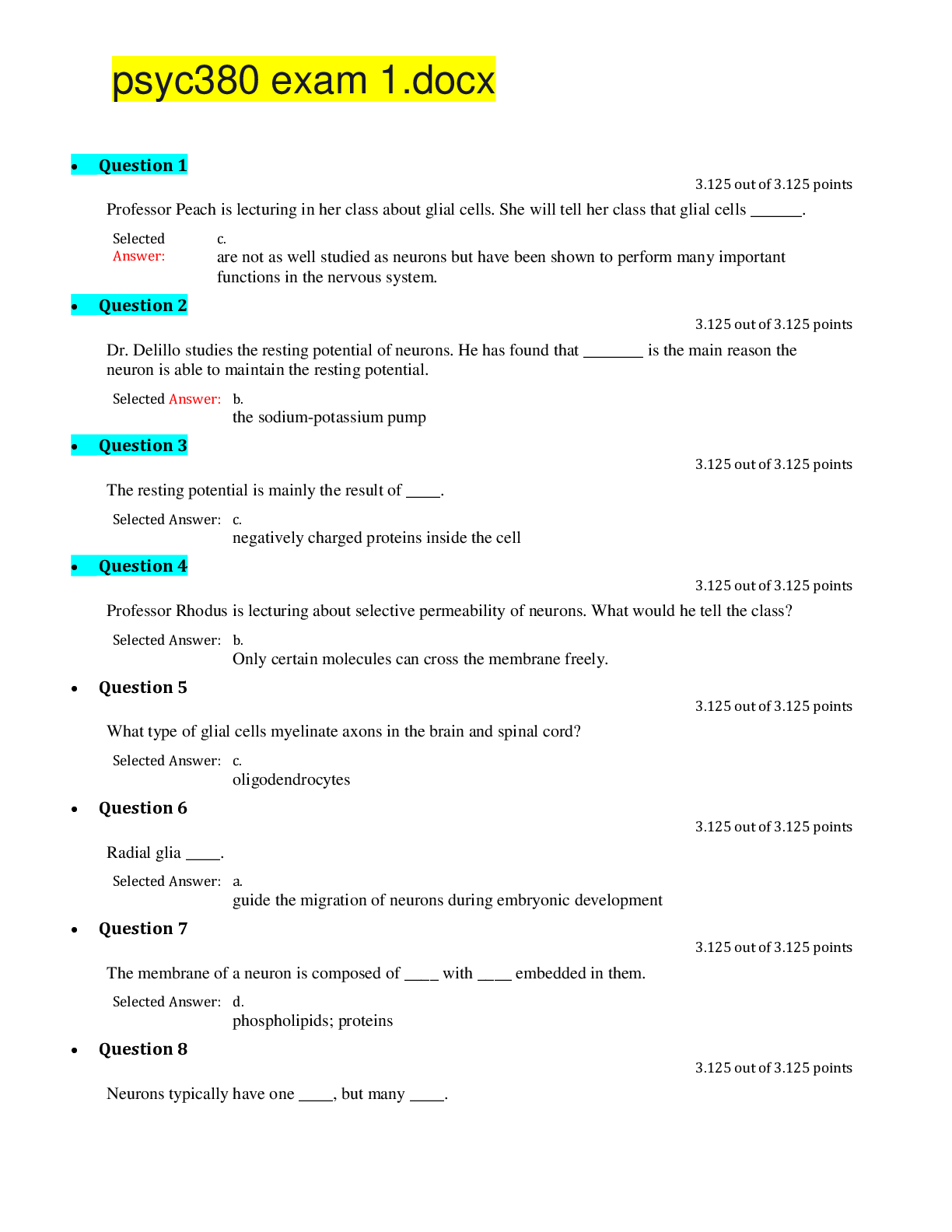
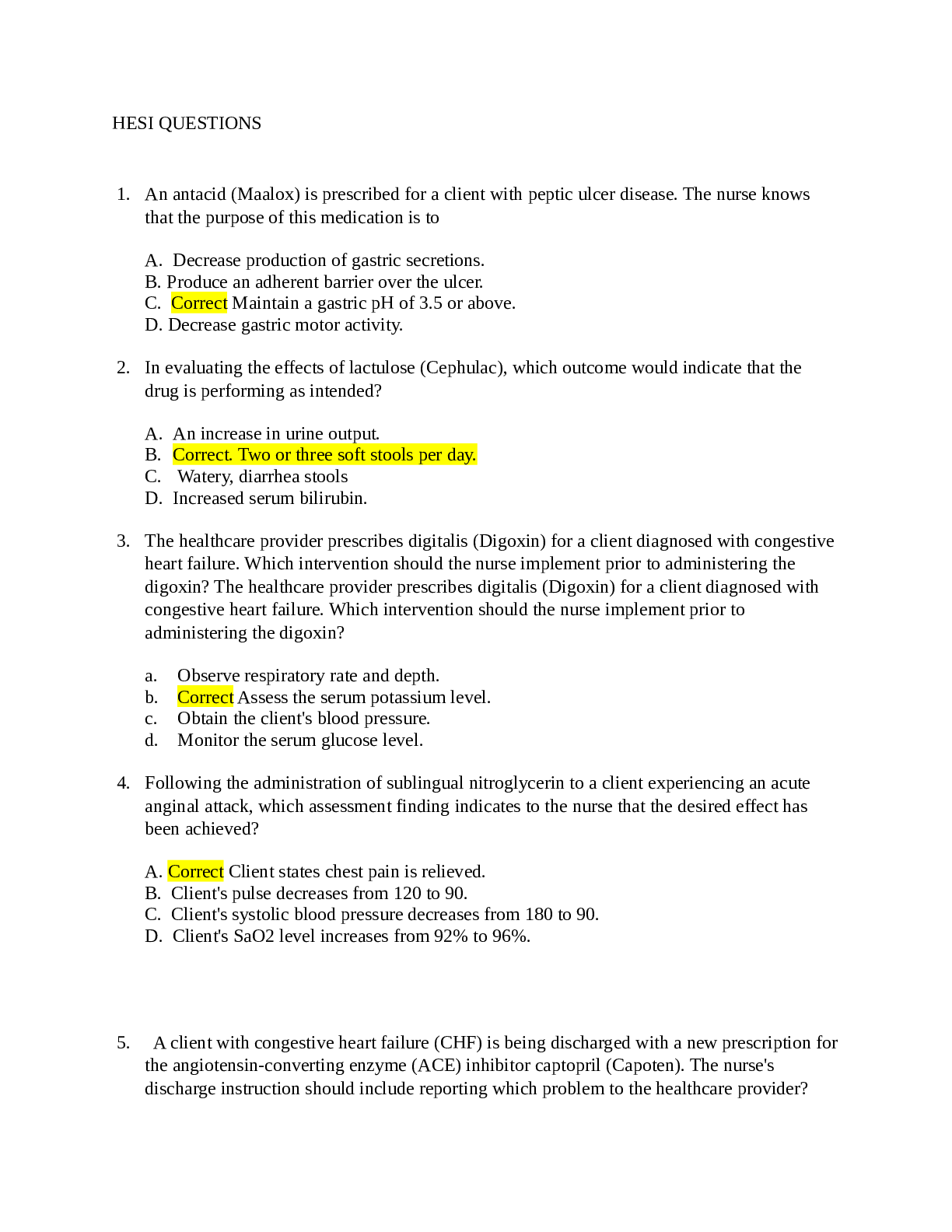



.png)


.png)












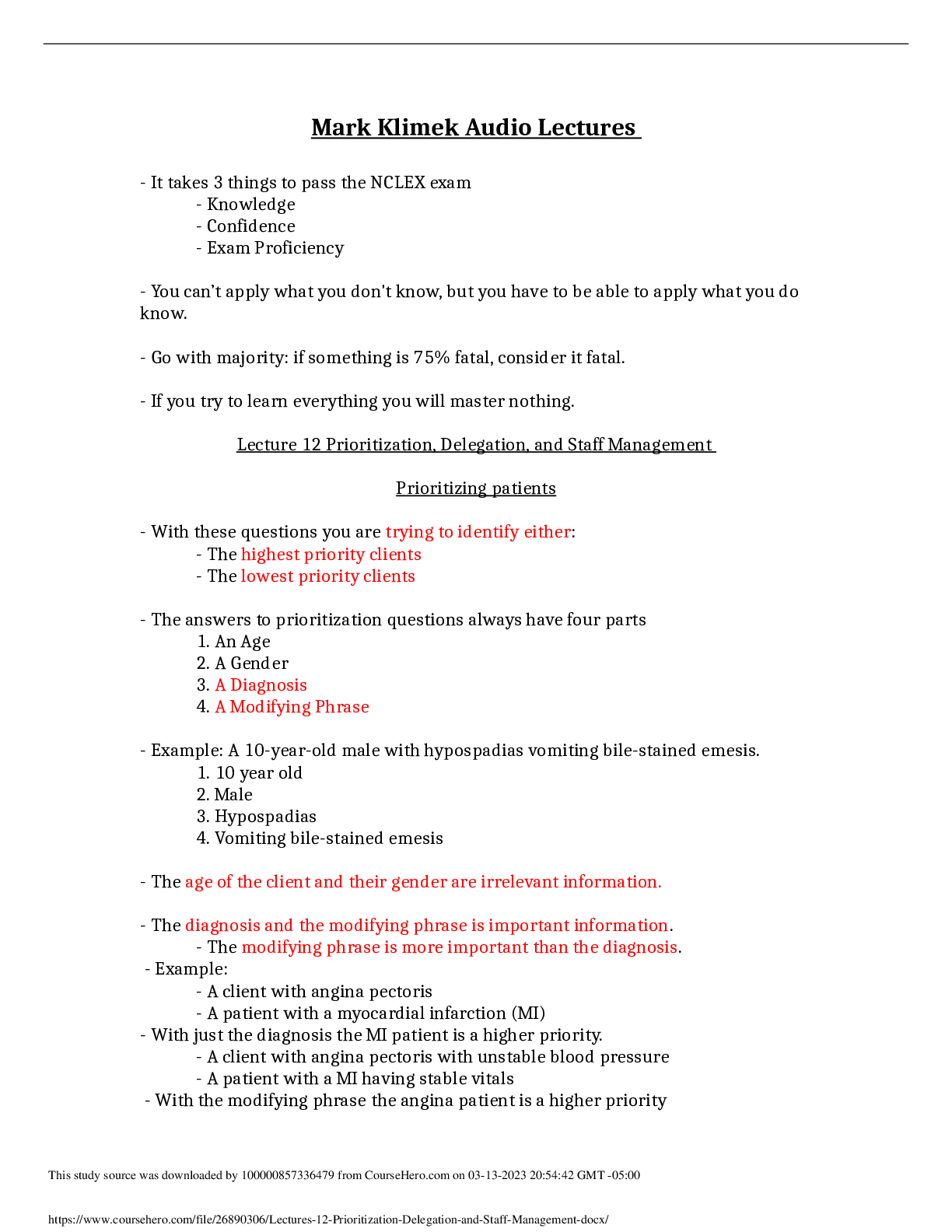



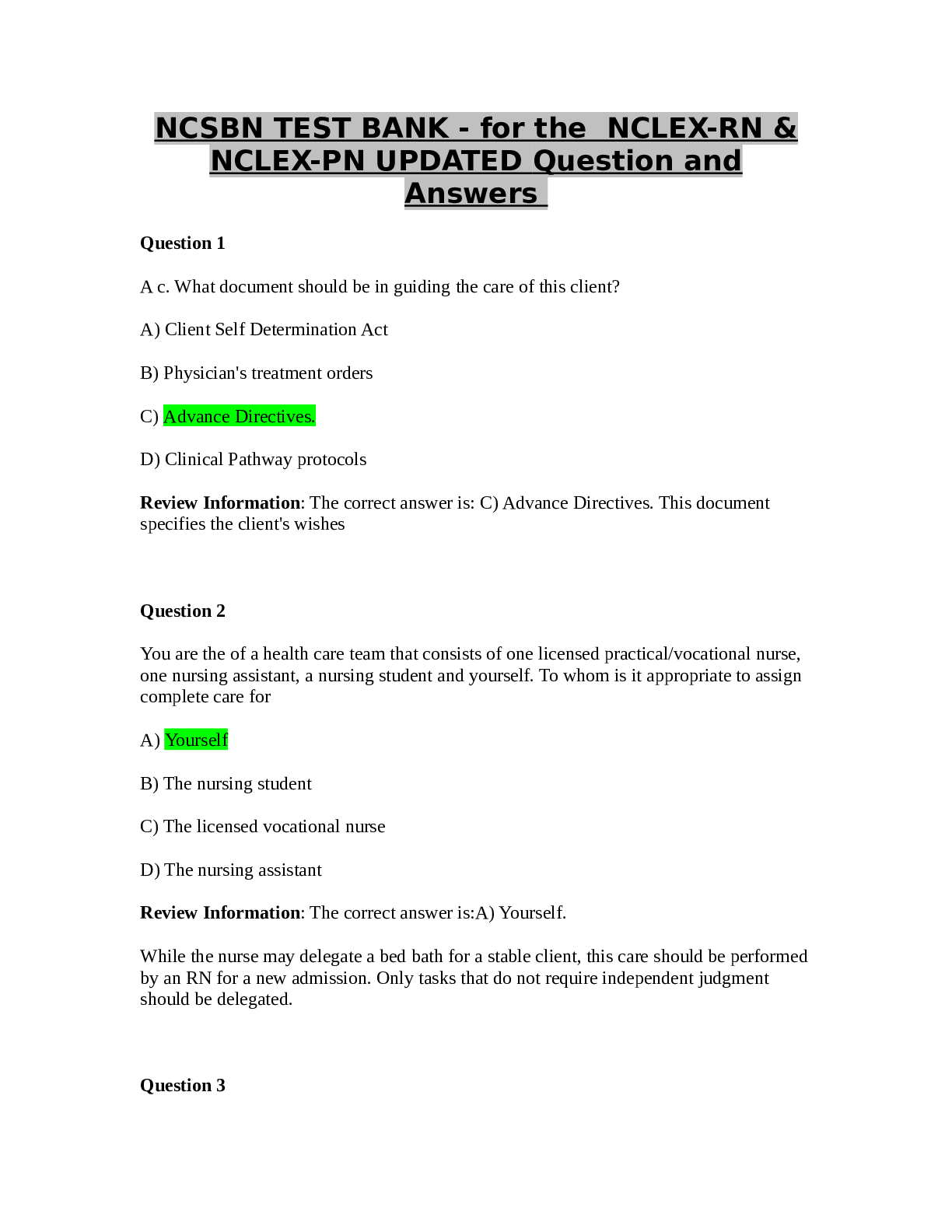
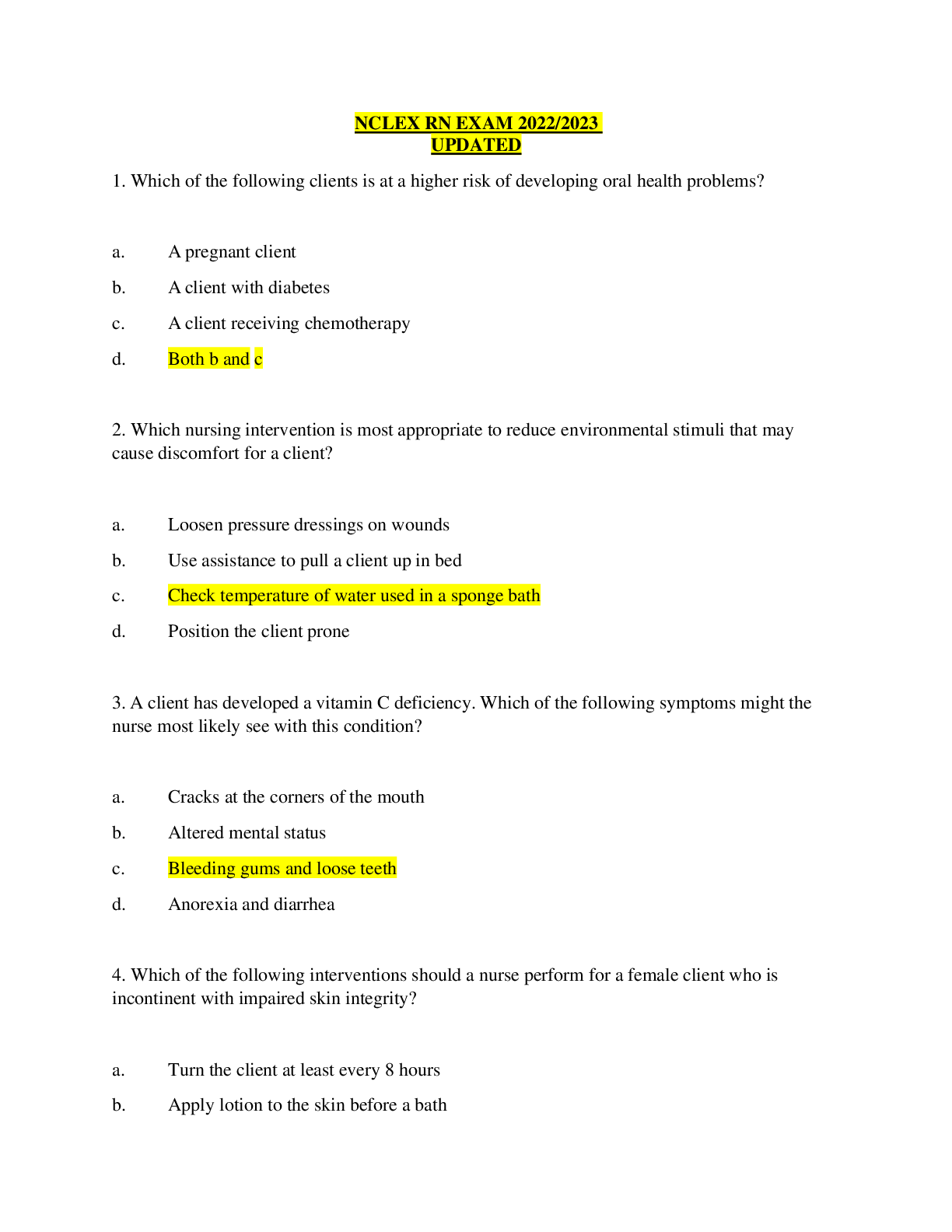
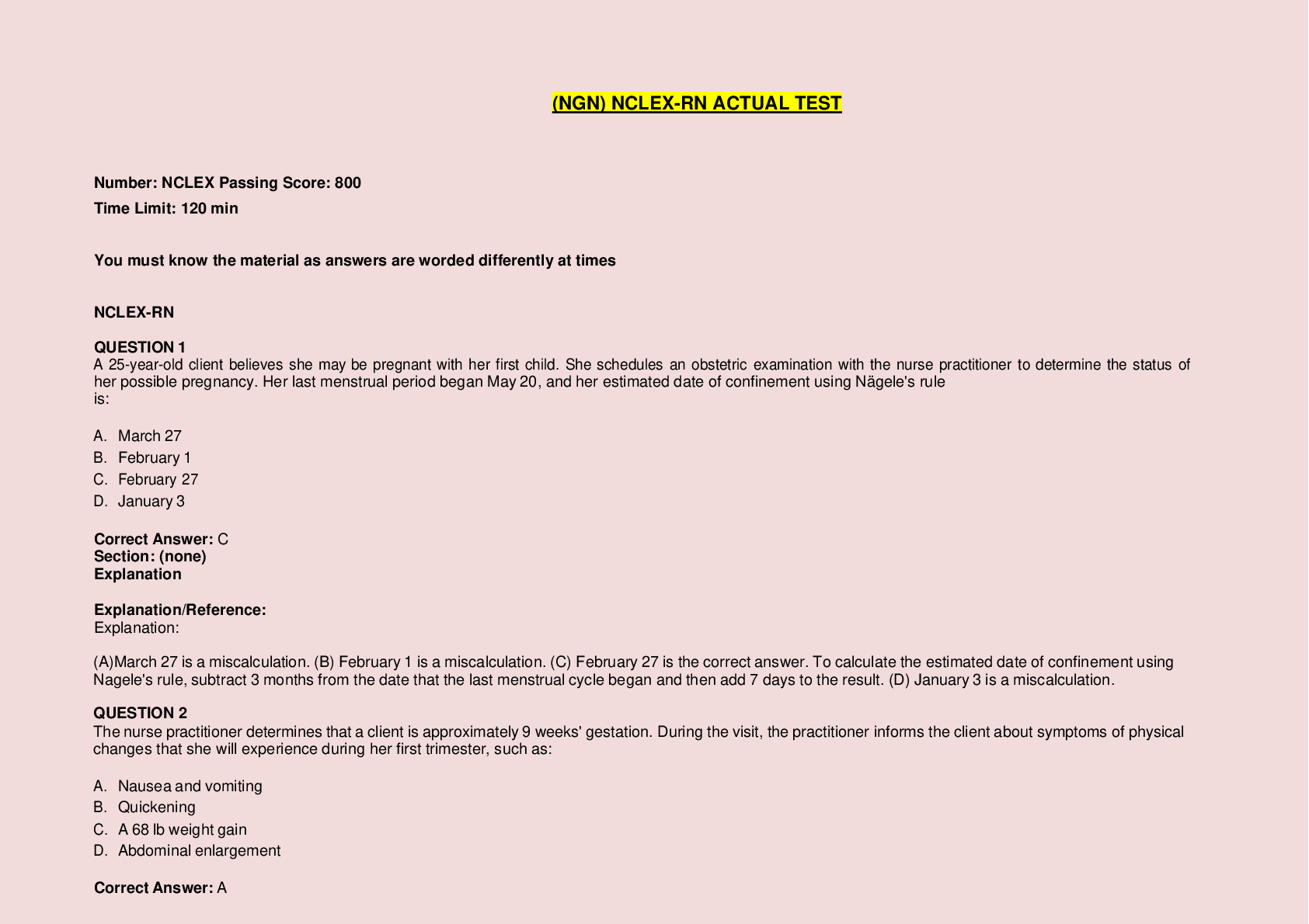
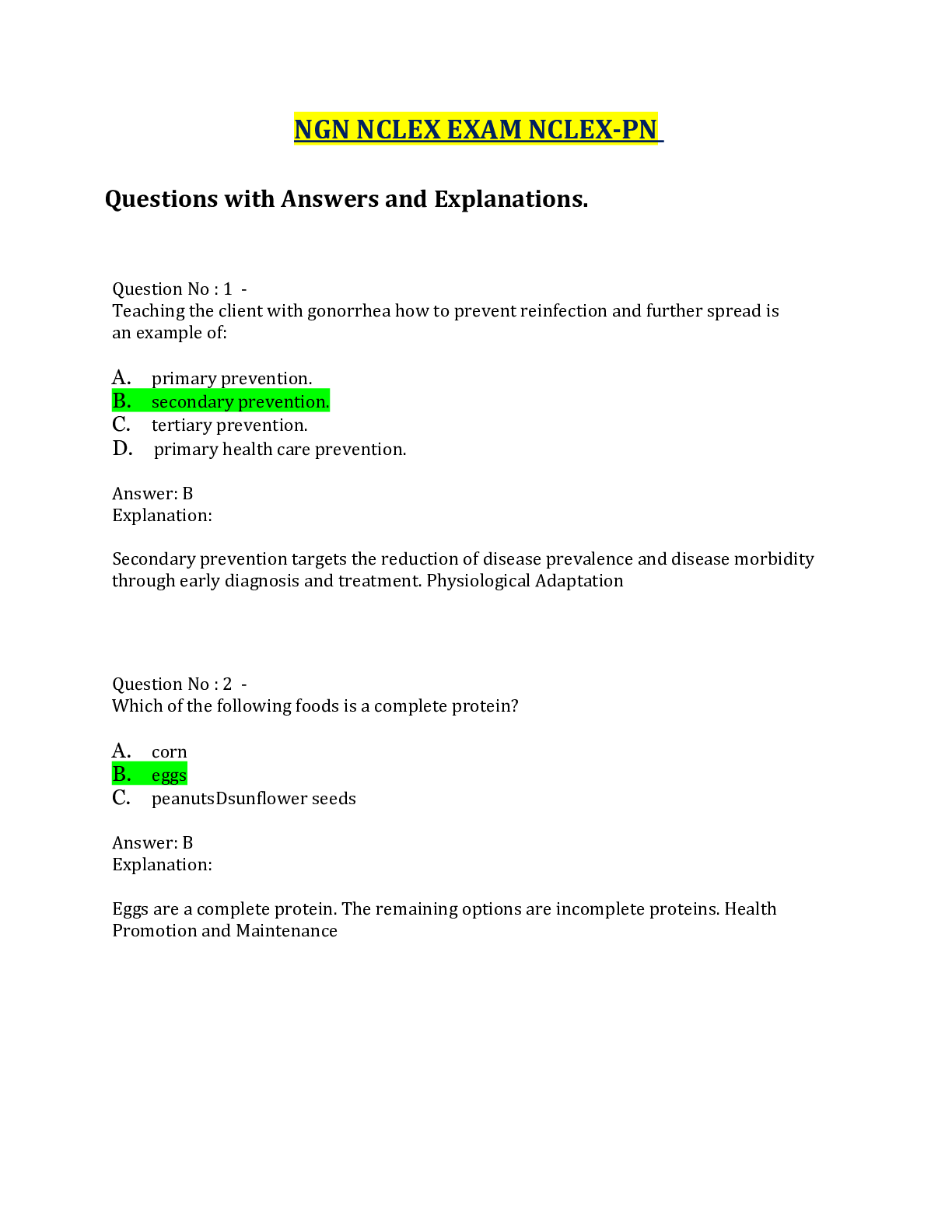

 JN21.png)

